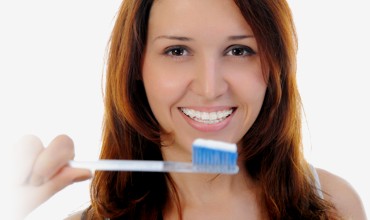 |

Patient Info
Caring for braces
Brushing techniques
You will be shown how to brush and floss when your braces are first
fitted. The best way to ensure a clean and healthy smile is by brushing
and flossing. The most important area to brush is between the braces
and the gum. This area “traps” a lot of food, and plaque forms quickly.
Orthodontic appliances do not cause cavities, but because of their
presence, plaque and food particles are retained more readily. To
avoid these problems while you are in orthodontic treatment, please
take special care of your braces, teeth and gums to ensure you will
achieve the best possible result.
 Brushing
your teeth will take a lot longer now that you have braces on. Any
brush with soft bristles and a small head that is comfortable to hold
is fine. Hold the toothbrush not on top of the braces, but on the
gums, wriggling in small circles. You can then push the bristles of
the brush under the wires from above and below the braces to remove
food and more importantly, plaque from under the wires. This will
require placing the brush in one spot, then pushing the bristles.
Brushing
your teeth will take a lot longer now that you have braces on. Any
brush with soft bristles and a small head that is comfortable to hold
is fine. Hold the toothbrush not on top of the braces, but on the
gums, wriggling in small circles. You can then push the bristles of
the brush under the wires from above and below the braces to remove
food and more importantly, plaque from under the wires. This will
require placing the brush in one spot, then pushing the bristles.
In addition to your normal toothbrush, an interdental or proxybrush
may assist in cleaning underneath and around your wires and braces.
During orthodontic treatment it is recommended that you brush your
teeth for at least 5 to 8 minutes at a time and after every meal,
approximately 3 times per day.
Extra protection for your teeth
While your braces are on, we recommend that you use a fluoride mouth
rinse weekly. Fluoride is a mineral that can strengthen your teeth
and make them more resistant to decay. Brush your teeth as normal,
then after rinsing out all the toothpaste, take 5-10ml of Fluorocare
in your mouth and swish vigorously for 30 seconds. Spit this out and
then leave the residue sitting on your teeth for at least 30 minutes.
It is best if this is done just before going to bed, then the fluoride
will be working to strengthen your teeth all night.
 Foods
to avoid
Foods
to avoid
When you start wearing braces you should avoid the following foods:
-
Hard foods such as nuts and candy
-
Sticky foods such as caramels and gums
-
Chewy foods such as hard rolls, crusty bread and pizza crust, licorice
-
Crunchy foods such as popcorn, ice and chips
-
Foods you have to bite into such as corn on the cob, apples, carrots
-
Chewing on hard things such as pens and pencils or fingernails
Patient Info:
Make an appointment
![]() Caring for braces
Caring for braces
Emergency
©
Mosman Park Orthodontics ![]()
Scroll
to top
